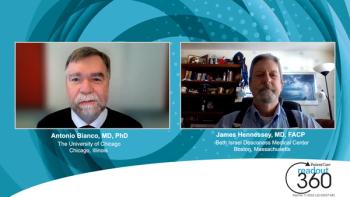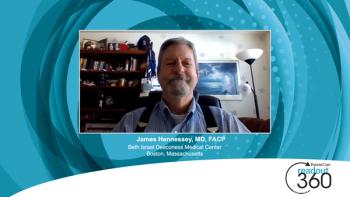
Follow-up of Well-Differentiated Thyroid Cancer in Primary Care
Surveillance after surgery for WDTC requires close clinical collaboration and primary care is an integral element.
The incidence of well-differentiated thyroid cancer (WDTC) has risen over the last generation.1 The term “well-differentiated” refers to 3 varieties of tumor: papillary, follicular, and hurthle cell or oncocytic follicular cell thyroid cancers. Since this specific subset of thyroid cancer has an excellent 10-year survival rate (93%), early diagnosis, appropriate treatment, and follow-up to identify persistence of occult disease or recurrence are important.1 Earlier detection of either occult thyroid tissue after surgery or recurrence later can save lives. Although initial curative therapy is surgical in nature, surveillance is a team approach which includes a number of primary care contributions.
The cure
The curative treatment of WDTC is usually a total thyroidectomy with or without lymphadenectomy.1 Understanding what factors contribute to increased risk after surgery is essential to surveillance. The 2 most important risk factors are patient age at presentation and tumor stage.2 For example, increased risk of death from WDTC begins in the 4th decade and rises significantly after age 60 years.1 As expected, small tumors have a better prognosis than larger ones (>1.5 cm).1 As with malignancies of all types risk in increased by:1
⺠Extra-thyroidal extension (minimal extension is associated with 3%-9% recurrence rates; extensive with 23%-40%)
⺠Vascular invasion (confers a higher risk of recurrence, distant metastases, and long term adverse outcomes)
⺠Lymph node involvement
In the case of lymph nodes and WDTC, micrometastases (<0.2 cm in ≤5 nodes) confer only a 5% risk of recurrence while masses >3 cm in size involved in lymph nodes raise the risk of recurrence to 20%.1
Which patients receive radioactive iodine after surgery?
The markers for increased risk described above affect a decision to add radioactive iodine (RAI) to the treatment of WDTC. Tumors >4 cm in size or distant metastases warrant additional therapy with RAI. Extension of the tumor outside the thyroid area at surgery, vascular invasion, and an unstimulated postoperative thyroglobulin (TG) of >5 ng/mL also suggest the need for RAI.3 Persistence of elevated TG after thyroidectomy suggests thyroid malignant cells are still present and require targeted treatment after surgery. WDTC confers the advantage of malignant cells that maintain the ability to uptake the “Trojan Horse” of RAI.
Monitoring in primary care
TSH (thyroid stimulating hormone) suppression is recommended after initial treatment in patients with higher-risk WDTC.1 If there are occult WDTC cells remaining, a decreased TSH is less likely to stimulate the growth of those malignant cells. Remember that sustained suppression of TSH may lead to osteopenia and/or osteoporosis.1 Primary care physicians are in a strategic position to order bone densitometry; recommend vitamin D and calcium supplementation; and prescribe therapy like bisphosphonates when necessary.
TSH suppression also must be carefully monitored in patients with coronary artery disease. Although this cohort will be under the care of a cardiologist, the primary care physician is often responsible for many of their medications (beta-blockers, for example).
Long-term surveillance also should include physical examination with particular attention to the surgical site and surrounding lymph node regions.1 When TSH is serially followed, TG is also drawn to identify either persistent or recurrent WDTC. TG is only produced by thyroid tissue so it is an important laboratory marker for occult remaining thyroid tissue.
High resolution ultrasound is a sensitive and non-invasive method to discover persistent or recurrent WDTC in the neck.1 When there is a suggestion of distant WDHC, or there is a high risk of recurrence (TG >10ng/mL), PET scanning can be valuable.1 More aggressive subtypes of WDTC may not be as iodine-avid so PET may be the only method able to pinpoint the metastatic disease.1 Obviously the surgeon and endocrinologist are helpful in this regard, but careful examination by primary care providers can have a positive impact.
The staging, treatment, and follow up of WDTC require knowledge of basic thyroid physiology (TSH, cellular iodine avidity, and TG), anatomy, and fundamental oncologic principles (size, vascular and lymph node invasion). In addition, surveillance and postoperative interventions (such as suppression of TSH), require primary care contributions (such as diagnosing and treating osteoporosis) in the context of a team approach. If a WDTC patient is lost to subspecialty follow up, primary care providers can contribute greatly.
2
References:
1. Yoo JY, Stang MT. Current guidelines for postoperative treatment and follow-up of well-differentiated thyroid cancer. Surg Oncol Clin N Am. 2016;25:41-59.
2. Hundahl SA, Fleming ID, Fremgen AM, et al. A National Cancer Data Base report on 53,856 cases of thyroid carcinoma treated in the U.S., 1985-1995. Cancer 1998;83:2638-2648.
3. Cooper DS, Doherty GM, Haugen BR, et. al. American Thyroid Association Guidelines Task Force on Thyroid Nodules and Differentiated Thyroid Cancer. Thyroid. 2009;19:1167-1214.
Newsletter
Enhance your clinical practice with the Patient Care newsletter, offering the latest evidence-based guidelines, diagnostic insights, and treatment strategies for primary care physicians.



























































































































































































































































































